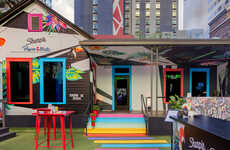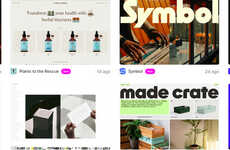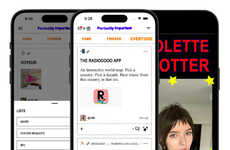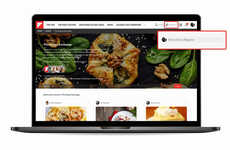
Felson Sajonas only started SwipeLife a year ago, but the site is quickly becoming a go-to for finding curious and fascinating things. From fashion to gadgets, SwipeLife is called a men’s lifestyle and fashion magazine. As I consider myself a loyal reader, though, I think they’re a lifestyle magazine for all.
We recently talked with Felson Sajonas about the role trend spotting plays in his work with SwipeLife.
13 Questions with Felson Sajonas
1. How did you get involved with SwipeLife and what motivates you to continue?
SwipeLife was started while I was an intern at the fashion trend forecasting agency, WGSN. While there, I experienced firsthand the editorial side of trend hunting and trend reporting. The great part about WGSN is that it didn’t just concentrate on fashion. It’s a full service agency that researched trends in electronics, automobiles, toys, music, film, etc.
I spent some time being a part of different projects there that ranged from womenswear/menswear trends to lifestyle trends. It was a unique experience, and it really motivated me to somehow create an outlet for all of the things I found fascinating.
I’ve always wanted to start something that involved my close friends, and since a lot of our interests were the same, I proposed to them the idea of starting an online men’s lifestyle magazine. In figuring out which topics we should cover on the site, we gathered our favorite men’s magazines ranging from GQ to Esquire, Monocle, L’uomo Vogue, and Another Man, and did research on the things we liked the most.
One day at Barnes and Noble, I picked up two magazines. It was the design issue of Details and the men’s fashion issue of I-D magazine. The design issue of Details covered the topic of design with gadgets, electronics, cars, and architecture, while the men’s fashion issue of I-D covered these great menswear brands whose designs were very progressive and appealing.
After going through both these issues, I asked myself why men’s magazines couldn’t be more like a combination of these things. I knew right then and there that these would be the topics we’d cover on the site. I wanted it to be a men’s online lifestyle magazine for the design-minded guy, but at the same time appealing enough for readers who are seeking things other than just “design” concentrated material.
After all that, we finally started SwipeLife in October of 2008, and we’re still going. We’re pretty satisfied with the content thus far, although we’d still like to cover a bit more. We have the best contributors and editors because they’re passionate about the material we cover. They’re either a part of the industry as designers, or long-time appreciators of the different cultures and topics we cover.
Our motivation for continuing is really being able to give our readers quality content that are always interesting and fascinating to read. We also want to assure our readers that whether your a fashion enthusiast, a gadget hound, a car junkie, or a design aficionado, SwipeLife will always be there to help feed their curiosities.
2. How significant are the topics of cool hunting and trend spotting to SwipeLife?
It’s very significant. You’ll see throughout our posts the emerging and continuing trends in the subjects we cover. For example, in fashion, you might see patterns, colors and silhouettes on one designer’s collection, and actually see some similarities in another designer’s.
If a certain color plaid or tartan pattern is prevalent in one season, you’ll know that this will be an important trend, and it will likely make it to the wardrobes of our readers and to those who are avid fashion consumers.
In terms of other things like car design and electronics, you might notice that minimalist designs, green energy use, or a new take on luxury marketing becoming a pattern. These emerging trends are important to us because it's what keeps our readers interested--especially if they are able to apply these trends or “cool” finds into their lifestyles.
3. How do you define a trend?
A trend is a slow and gradual movement towards impact. Once the impact happens, everyone is affected, whether good or bad. Traces of its original form are there after the occurrence, but as time moves on, whatever impacted us in the first place starts to become less recognizable and ultimately ignored. That’s of course until the next major or minor impact comes along.
Essentially, trends can be viewed as ideas both tangible and intangible that people find interesting enough to actually want to experience (i.e. wearing a keffiyeh scarf or doing Pilates). Once the experience is completed, it’s basically the spreading of this trend by either word of mouth, or other media channels (television, newspapers, magazines, blogs, etc.) that make them more prevalent and pervasive.
The more you see it and hear about it, the more it takes the shape of a trend, and at some time this idea will reach its tipping point, take a new form, and will become hard to ignore until you find yourself trying it out.
But usually for those who are slow to catch on, by the time they have tried it out, it either becomes old news or something that has become uncool. Basically, trends are life-defining experiences. You’re either aware of it, or you just don’t care about it, but you know it‘s definitely there.
4. How do you define cool?
Personally, I think “cool” is doing something worthwhile without “trying” too hard. It’s something that comes naturally, and the people that take notice are genuinely appreciative of what you’ve created or offered to the world. In terms of product and design, cool is being honest with what you’re making.
It’s about what really personally inspires you, and not about what everyone else is doing. Cool is ageless, time tested, supreme in quality, brave, original… I could go on with defining the word, but then that would eventually be “uncool.”
5. Do you need a culture of innovation to create something that is cool?
Not necessarily. Filmmaker Jim Jarmusch (who is definitely cool) said, “Nothing is original. Steal from anywhere that resonates with inspiration or fuels your imagination.”
I think it holds true today that originality is dead. A lot of the things we discover and find appealing are just either evolved, mutated or slightly transformed versions of their original form. And I feel that there’s nothing wrong with that.
We live in a culture of influence, and it’s usually the amalgam of things we’ve seen and experienced that inspires us to create something. We can’t help it. What’s important is how you stay true to the execution and delivery of what you’re creating, and that is what makes something cool.
Actually, here is the full Jim Jarmusch quote:
6. What is the best way to create an infectious idea, product or service?
The best way really is to first concentrate on perfecting the product and service, then think about how it will become infectious later. I’m a firm believer that if you work hard to create a superior product or service that people can trust, then more consumers, clients, fans, etc. will follow later on.
After you have perfected your product or service, the next important order of business is how you interact with everyone that connects with your brand or service. From consumers, to buyers, to press, to media, and to the new potential customer, you have to always be ready to answer questions, fix problems, meet demands, and stay honest about your business practices.
Positivity breeds positivity, and the more you make good with everyone, the more people will take notice and latch on--hence becoming infectious.
7. What is the key to innovation?
Trial and error. Learning from mistakes and having the gumption to move forward. It’s about studying and carefully researching history, and being inspired by what others have accomplished in the past.
It’s about taking chances, exceeding expectations, and breaking barriers. The key to innovation is having the mental, physical, and emotional fortitude to surpass your goals. If you don’t possess these qualities then you can’t be an innovator.
8. What is the most important trend you see in your industry?
In the blogging/new media industry, the one important trend I see is user interaction. It’s not just about connecting with your audience on a social networking level these days anymore (twitter, facebook, etc.), it also has to be about the importance of engaging your audience on an interactive level.
While blogging is more of a personal habit, I feel that sites whose editorial style is on a blog format like ours will look to some way to get the readers involved. It’ll be interesting to see how sites will follow up on these concepts.
9. What are your ambitions for SwipeLife?
We honestly just want to stay consistent and see what happens. We’re only less than a year old, and we feel we could still do more in the years to come. We want to do our best to give current and new readers quality material they will always appreciate and come back to.
We’d also like to do more features and interviews with brands, designers, car manufacturers, hoteliers, etc. so that readers can see what goes on behind the scenes of some of the brands and names they follow. We’d also like to produce more original content, which we’re currently working on.
As for user interaction, we would like to somehow get some of our readers involved. We want to find a way to create a forum for them to interact as a community when it comes to the things we write about. But we’ll see how that goes.
10. How do you reset yourself to be creative? Do you have any rituals?
I’ve always told myself that I should buy a mini journal to write down the ideas that come to my head. I have yet to buy this mini journal. I don’t really set a time to be creative, because I like my creativeness to be spontaneous.
Oftentimes this happens late at night, when I’m about to wrap up some content for the site. So a lot of times, I do end up staying later than planned, and I’m either writing or crafting something on the computer till the very late hours.
11. Professionally, what do you want to be doing in 10 years?
I just want to be able to do something that allows me to stay close to my family, if I ever have kids at that time. I want to work diligently on something that I can leave for my children when I’m gone. It could either be a new business venture I haven’t thought of yet or SwipeLife itself. As long as I’m happy doing it and I believe in it with all my heart, then that’s what I want to be doing in 10 years or so.
12. What are your most important hobbies?
My most important hobbies are staying active. I’m currently taking Muay Thai, because learning a martial art was something I’ve always wanted to do but never really pursued. I’m an avid basketball and tennis player, and I love spending time with my nephews because it gives me a reason to act like a kid again.
My other hobbies include trying out new foods, watching films, going on road trips, and watching live sports events. I spend a lot of time in front of the computer, so I’m grateful anytime I have the chance to be away from the glowing box screen.
13. What is an example of a time where you have thrown away an existing idea to force yourself to find something new?
Actually before we decided on what content we’d finally put on SwipeLife, we had ideas for other websites as well. One was a fashion advice magazine, and the other was a restaurant/travel review site where people can write about their dining or hotel experiences.
These were great ideas at the time, but we figured that neither one really captured all of our interests collectively. So we threw those ideas out and eventually came to deciding on SwipeLife.
We recently talked with Felson Sajonas about the role trend spotting plays in his work with SwipeLife.
13 Questions with Felson Sajonas
1. How did you get involved with SwipeLife and what motivates you to continue?
SwipeLife was started while I was an intern at the fashion trend forecasting agency, WGSN. While there, I experienced firsthand the editorial side of trend hunting and trend reporting. The great part about WGSN is that it didn’t just concentrate on fashion. It’s a full service agency that researched trends in electronics, automobiles, toys, music, film, etc.
I spent some time being a part of different projects there that ranged from womenswear/menswear trends to lifestyle trends. It was a unique experience, and it really motivated me to somehow create an outlet for all of the things I found fascinating.
I’ve always wanted to start something that involved my close friends, and since a lot of our interests were the same, I proposed to them the idea of starting an online men’s lifestyle magazine. In figuring out which topics we should cover on the site, we gathered our favorite men’s magazines ranging from GQ to Esquire, Monocle, L’uomo Vogue, and Another Man, and did research on the things we liked the most.
One day at Barnes and Noble, I picked up two magazines. It was the design issue of Details and the men’s fashion issue of I-D magazine. The design issue of Details covered the topic of design with gadgets, electronics, cars, and architecture, while the men’s fashion issue of I-D covered these great menswear brands whose designs were very progressive and appealing.
After going through both these issues, I asked myself why men’s magazines couldn’t be more like a combination of these things. I knew right then and there that these would be the topics we’d cover on the site. I wanted it to be a men’s online lifestyle magazine for the design-minded guy, but at the same time appealing enough for readers who are seeking things other than just “design” concentrated material.
After all that, we finally started SwipeLife in October of 2008, and we’re still going. We’re pretty satisfied with the content thus far, although we’d still like to cover a bit more. We have the best contributors and editors because they’re passionate about the material we cover. They’re either a part of the industry as designers, or long-time appreciators of the different cultures and topics we cover.
Our motivation for continuing is really being able to give our readers quality content that are always interesting and fascinating to read. We also want to assure our readers that whether your a fashion enthusiast, a gadget hound, a car junkie, or a design aficionado, SwipeLife will always be there to help feed their curiosities.
2. How significant are the topics of cool hunting and trend spotting to SwipeLife?
It’s very significant. You’ll see throughout our posts the emerging and continuing trends in the subjects we cover. For example, in fashion, you might see patterns, colors and silhouettes on one designer’s collection, and actually see some similarities in another designer’s.
If a certain color plaid or tartan pattern is prevalent in one season, you’ll know that this will be an important trend, and it will likely make it to the wardrobes of our readers and to those who are avid fashion consumers.
In terms of other things like car design and electronics, you might notice that minimalist designs, green energy use, or a new take on luxury marketing becoming a pattern. These emerging trends are important to us because it's what keeps our readers interested--especially if they are able to apply these trends or “cool” finds into their lifestyles.
3. How do you define a trend?
A trend is a slow and gradual movement towards impact. Once the impact happens, everyone is affected, whether good or bad. Traces of its original form are there after the occurrence, but as time moves on, whatever impacted us in the first place starts to become less recognizable and ultimately ignored. That’s of course until the next major or minor impact comes along.
Essentially, trends can be viewed as ideas both tangible and intangible that people find interesting enough to actually want to experience (i.e. wearing a keffiyeh scarf or doing Pilates). Once the experience is completed, it’s basically the spreading of this trend by either word of mouth, or other media channels (television, newspapers, magazines, blogs, etc.) that make them more prevalent and pervasive.
The more you see it and hear about it, the more it takes the shape of a trend, and at some time this idea will reach its tipping point, take a new form, and will become hard to ignore until you find yourself trying it out.
But usually for those who are slow to catch on, by the time they have tried it out, it either becomes old news or something that has become uncool. Basically, trends are life-defining experiences. You’re either aware of it, or you just don’t care about it, but you know it‘s definitely there.
4. How do you define cool?
Personally, I think “cool” is doing something worthwhile without “trying” too hard. It’s something that comes naturally, and the people that take notice are genuinely appreciative of what you’ve created or offered to the world. In terms of product and design, cool is being honest with what you’re making.
It’s about what really personally inspires you, and not about what everyone else is doing. Cool is ageless, time tested, supreme in quality, brave, original… I could go on with defining the word, but then that would eventually be “uncool.”
5. Do you need a culture of innovation to create something that is cool?
Not necessarily. Filmmaker Jim Jarmusch (who is definitely cool) said, “Nothing is original. Steal from anywhere that resonates with inspiration or fuels your imagination.”
I think it holds true today that originality is dead. A lot of the things we discover and find appealing are just either evolved, mutated or slightly transformed versions of their original form. And I feel that there’s nothing wrong with that.
We live in a culture of influence, and it’s usually the amalgam of things we’ve seen and experienced that inspires us to create something. We can’t help it. What’s important is how you stay true to the execution and delivery of what you’re creating, and that is what makes something cool.
Actually, here is the full Jim Jarmusch quote:
“Nothing is original. Steal from anywhere that resonates with inspiration or fuels your imagination. Devour old films, new films, music, books, paintings, photographs, poems, dreams, random conversations, architecture, bridges, street signs, trees, clouds, bodies of water, light and shadows.
Select only things to steal from that speak directly to your soul. If you do this, your work (and theft) will be authentic. Authenticity is invaluable; originality is non-existent. And don’t bother concealing your thievery - celebrate it if you feel like it. In any case, always remember what Jean-Luc Godard said: “It’s not where you take things from - it’s where you take them to.”
6. What is the best way to create an infectious idea, product or service?
The best way really is to first concentrate on perfecting the product and service, then think about how it will become infectious later. I’m a firm believer that if you work hard to create a superior product or service that people can trust, then more consumers, clients, fans, etc. will follow later on.
After you have perfected your product or service, the next important order of business is how you interact with everyone that connects with your brand or service. From consumers, to buyers, to press, to media, and to the new potential customer, you have to always be ready to answer questions, fix problems, meet demands, and stay honest about your business practices.
Positivity breeds positivity, and the more you make good with everyone, the more people will take notice and latch on--hence becoming infectious.
7. What is the key to innovation?
Trial and error. Learning from mistakes and having the gumption to move forward. It’s about studying and carefully researching history, and being inspired by what others have accomplished in the past.
It’s about taking chances, exceeding expectations, and breaking barriers. The key to innovation is having the mental, physical, and emotional fortitude to surpass your goals. If you don’t possess these qualities then you can’t be an innovator.
8. What is the most important trend you see in your industry?
In the blogging/new media industry, the one important trend I see is user interaction. It’s not just about connecting with your audience on a social networking level these days anymore (twitter, facebook, etc.), it also has to be about the importance of engaging your audience on an interactive level.
While blogging is more of a personal habit, I feel that sites whose editorial style is on a blog format like ours will look to some way to get the readers involved. It’ll be interesting to see how sites will follow up on these concepts.
9. What are your ambitions for SwipeLife?
We honestly just want to stay consistent and see what happens. We’re only less than a year old, and we feel we could still do more in the years to come. We want to do our best to give current and new readers quality material they will always appreciate and come back to.
We’d also like to do more features and interviews with brands, designers, car manufacturers, hoteliers, etc. so that readers can see what goes on behind the scenes of some of the brands and names they follow. We’d also like to produce more original content, which we’re currently working on.
As for user interaction, we would like to somehow get some of our readers involved. We want to find a way to create a forum for them to interact as a community when it comes to the things we write about. But we’ll see how that goes.
10. How do you reset yourself to be creative? Do you have any rituals?
I’ve always told myself that I should buy a mini journal to write down the ideas that come to my head. I have yet to buy this mini journal. I don’t really set a time to be creative, because I like my creativeness to be spontaneous.
Oftentimes this happens late at night, when I’m about to wrap up some content for the site. So a lot of times, I do end up staying later than planned, and I’m either writing or crafting something on the computer till the very late hours.
11. Professionally, what do you want to be doing in 10 years?
I just want to be able to do something that allows me to stay close to my family, if I ever have kids at that time. I want to work diligently on something that I can leave for my children when I’m gone. It could either be a new business venture I haven’t thought of yet or SwipeLife itself. As long as I’m happy doing it and I believe in it with all my heart, then that’s what I want to be doing in 10 years or so.
12. What are your most important hobbies?
My most important hobbies are staying active. I’m currently taking Muay Thai, because learning a martial art was something I’ve always wanted to do but never really pursued. I’m an avid basketball and tennis player, and I love spending time with my nephews because it gives me a reason to act like a kid again.
My other hobbies include trying out new foods, watching films, going on road trips, and watching live sports events. I spend a lot of time in front of the computer, so I’m grateful anytime I have the chance to be away from the glowing box screen.
13. What is an example of a time where you have thrown away an existing idea to force yourself to find something new?
Actually before we decided on what content we’d finally put on SwipeLife, we had ideas for other websites as well. One was a fashion advice magazine, and the other was a restaurant/travel review site where people can write about their dining or hotel experiences.
These were great ideas at the time, but we figured that neither one really captured all of our interests collectively. So we threw those ideas out and eventually came to deciding on SwipeLife.
Trend Themes
1. Men's Online Lifestyle Magazine - Opportunities for creating new content, features, and interview opportunities for brands, designers, car manufacturers, and hoteliers.
2. Trendspotting - Importance of keeping up with emerging and continuing trends in various industries for SwipeLife readers.
3. User Interaction - Potential to create a community for reader engagement in SwipeLife content.
Industry Implications
1. Publishing/media - Opportunities for launching and growing online lifestyle magazines with niche and appealing content like SwipeLife.
2. Fashion and Apparel - Importance of trend spotting in fashion design and marketing for clothing brands, boutiques, and retailers.
3. Technology/electronics - Opportunities to observe and report emerging trends in consumer electronics, gadgets, and green technology for SwipeLife readers.
3.1
Score
Popularity
Activity
Freshness























